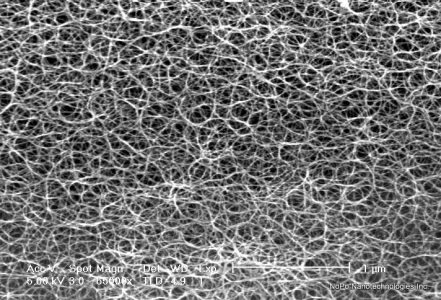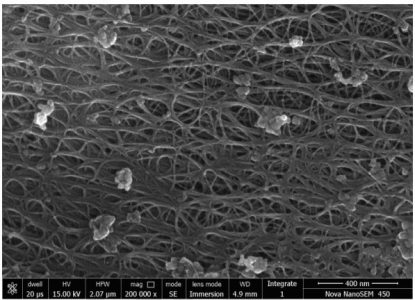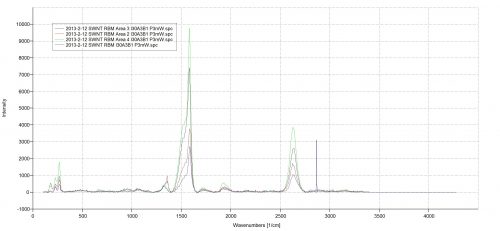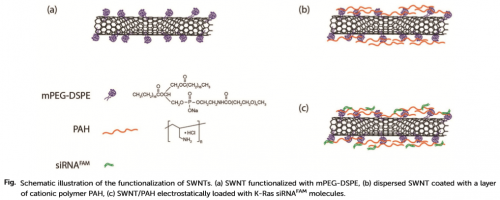

| Product | Residual Fe Catalyst |
Diameter | Length |
|---|---|---|---|
| Raw | <35% wt% | 0.8 – 1.2 | ~100 – 1,000 nm |
| Purified | <15% wt% | 0.8 – 1.2 | ~100 – 1,000 nm |
| Super Purified |
<5% wt% | 0.8 – 1.2 | ~100 – 1,000 nm |
Characterization Summary
| Individual SWNT Diameteri | ~0.8 – 1.2 nm |
| Individual SWNT Lengthii | ~400 – 700 nm |
| Color | Black, Dark Grey |
| Morphology | Dry fibrous powder |
|
Raman G/D Ratio (532nm) |
Raw: 35 Purified: 95 |
| Catalyst Content | <20 wt% (5 Atom%) as Fe |
| Carbon Purity |
>80 wt% (95 atom%) |
| Carbon as SWCNT (TGA) | >65wt% |
| Crystallinity (Raman Analysis) | High |
| Raman G/D ratio | Average: ~25
Highest 95@532nm Excitation |
Raman

- Diameter distribution measured by Unidym from TEM micrographs. Mean diameter ~1.0 nm.
- Measured by Unidym using AFM.
- Calculated. Lower limit assumes a SWNT with a diameter of 0.8nm and a length of 100nm. (0.8nm/0.245nm)(3.1414)(2 carbon atoms) = 20 carbons around the circumference. For every 0.283nm length there are 4×20=80 carbon atoms. (100nm/0.283nm)(80)(12.01) = 339,505 Amu. Assuming 2 significant digits = 3.4×105. Upper limit assumes a SWNT with a diameter of 1.2nm and a length of 1,000nm. (1.2nm/0.245nm)(3.1414)(2 carbon atoms) = 31 carbons around the circumference. For every 0.283nm length there are 4×31 = 124 carbon atoms. (1000nm/0.283nm)(124)(12.01) = 5,262,332 Amu. Assuming 2 significant digits = 5.2×106.

Product Applications
The use of NanoIntegris’ HiPco within scientific research has proven quite extensive. This small-diameter SWCNT material has found to be a valuable component for applications such as cancer therapy, battery electrode conductivity, electric field enhancement, thin film transistor creation, and gas sensors.
Biochemists at Nanyang Technological University have utilized NanoIntegris’ HiPco Raw powder as an siRNA nanoplex for the gene therapy of pancreatic cancer cells. [1] The 110 nm effective hydrodynamic diameter of the SWNT nanoplex makes them suitable for applications as nanocarriers for intracellular delivery and allowed them to be utilized for gene transfection against the mutant K-Ras gene in PANC-1 pancreatic cells.
Cells treated with the SWNT/PAH/SiRNA nanoplex formulation had the expression level of the targeted mutant K-Ras mRNA suppressed from 100±12.2% down to 66.88±5.14% while possessing low cytotoxicity and high biocompatibility. Such multifunctional and multimodal CNT formulations could be engineered for other advanced healthcare applications, integration with drug moecules, and prove beneficial in theranostics.
[1] Biomater. Sci., 2014, 2, 1244
Lithium Ion Battery Electrodes
In work performed at the Ulsan National Institute of Science and Technology, in conjunction with other Korean researchers, NanoIntegris’s HiPco SWCNTs were used to generate nanonets showing great promise as a broadly applicable platform technology for high-energy-density/ high performance energy conversion/ storage materials.
HiPco Super Purified powder was combined with PFO and OLO to form an OLO@mSC nanonet of metallic enriched material that enabled significant improvement in the areal mass loading of active materials in the OLO cathode while resulting in the higher areal capacity cells (1.62mAh/cm2 and 213mAh/g cathode). The OLO@mSC cathode showed high discharge capacity, high electronic conductivity ( ~0.10 S/cm), alleviated the rise in cell polarization, showed low internal cell resistances, high capacity retention during cycling (94% after 100 cyles) and facilitated the charge/ discharge reaction during cycling.
LNMO@mSC nanonets were also generated for use with LNMO cathodes. The LNMO@mSC showed a high capacity retention (97% after 200 cyles), had a low charge transfer resistance (RCT=6.6 Ω) with great growth suppression after cycling, indicating promise as electron-conductive shields.
The mSC nanonets were also investigated as a conducting coating layer on a perovskite catalyst – NSC. The NSC@mSC nanonets showed a high ORR onset potential (~-0.12 V) a large diffusion limiting current density (-5.2 mA/cm2), a low Tafel Slope (115 mV per decade), high current density, lower onset potential, and long-term stability after 1000 cyles (91.2%), all indicating that the NSC@mSC may be a promising bifunctional ORR/OER catalyst.
[1] J. Mater. Chem. A, 2017, 5, 12103-12112
Product Delivery
All HiPco Purified and Super Purified products are offered as a dry, granular powder.
We currently offer our HiPco Raw nanotube products in two forms: Fluffy Powder and Wet Cake. Due to safety concerns with handling the extremely low-density raw material, the HiPco Raw product is provided as a wet cake for orders of greater than 5g unless otherwise requested. The wet cake is roughly 10wt% nanotubes. The remaining mass is a mixture of 10% ethanol and 90% water, which can be easily removed by thermal or centrifugal treatment. (e.g. 10.70g of wet cake will be provided for a 1g HiPco Raw SWNT order.
HiPco Pricing
Multi-gram and kilogram price quotes available by request. Additional discounts also available for large volume orders.
To place an order contact our Sales Manager at sales@nanointegris.com or call +1-866-650-0482.
ONLINE SHIPPING CHARGES: International (Asia, Europe, India): $100.00, United States: $50, Canada: $30
| Product Type | Price/gram ($ USD) |
|---|---|
| Raw Fluffy Powder | $615 |
| Raw Wet Cake | $680 |
| Raw Dense Powder | $700 |
| Purified | $900 |
| Super Purified | $2240 |

